17th Century Tokens
17th Century Tokens
Because of their small size these illustrations have been enlarged 25% to 50% depending on your computer screen.
A TCS survey in 2004 revealed 17th cent tokens to be the most widely-loved of all British tokens; and rightly so, because of their personal nature and diverse range of subject matter. Municipal issues apart, they are highly individual and identifiable, relating to ordinary people who can be frequently identified in the parish registers and other local documents of the time. For a combination of age and traceability, the 17th cent token series is a breakeven which cannot be beaten; there are even a few issued by inns and pubs which are still trading today, one third of a millennium later.
The series is generally taken to refer to pieces in various alloys of copper and brass which were struck between 1648 and 1672, and semi-officially tolerated, in a period when the amount of officially available small change was woefully inadequate. The start of issue was stimulated by a combination of the death of Charles I on 30 January 1648/9 and a public reaction against the little tinny pieces issued by certain of the royal favourites, under licence, during the period 1613-48. The end came about in response to an official edict, issued in 1672 after the introduction of a proper royal copper coinage, that in consequence of official provision now being made, the use of unofficial privately-issued coinage had to cease.
Issues started in the Home Counties within weeks of Charles’ demise and spread rapidly across southern and eastern England and the Midlands. In Wales and Northern England token issue was often quite sparse and did not start before 1656 or even later; Durham, strongly Royalist and indicated as such on its tokens, was one of two or three counties which did not issue until after the Restoration. With one exception, the series did not reach Scotland, whose independent official coinage was obviously deemed adequate. Ireland had a parallel series, broadly similar, but with the penny predominant; good copper pieces did not arrive there until 1680, and the tokens thus lingered on, despite official discouragement, throughout the 1670s. With the exception of the very common piece of Mic Wilson of Dublin in 1672, they tend to be rarer than their counterparts from the British mainland.
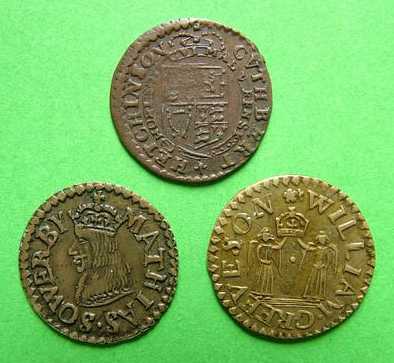
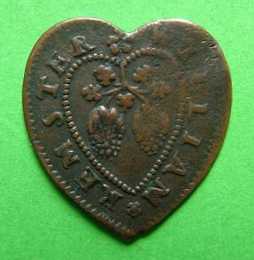
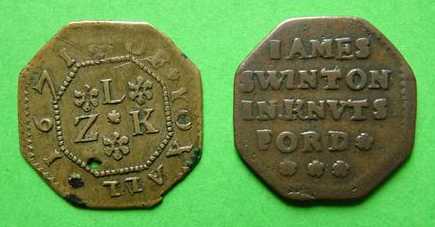

There are currently in excess of 14,000 known types, with more continually coming to light. Most are round, although heart-shaped, octagonal and other irregular pieces exist in small quantity and always command a premium. As to the metal, the alloys are various and depend on what combination of ingredients the manufacturer had available at the time. Light, medium and rich hues of brass may be distinguished, as also pieces of very pure looking brown copper and extremely dark pieces which possibly contain antimony. Others feel and sound tinny, or are more nondescript; they were struck to no standard, the only criterion being what the public would accept.
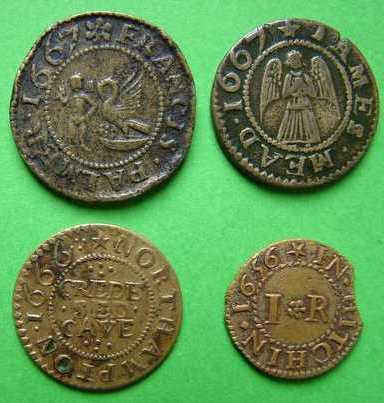
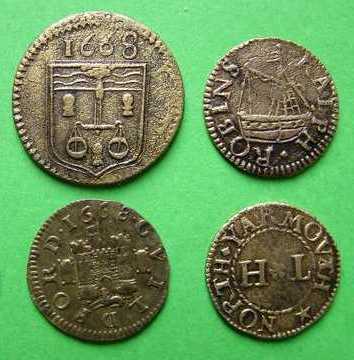
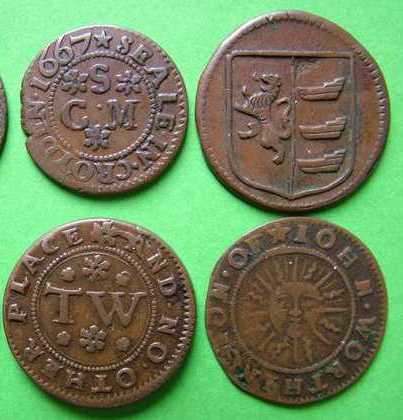
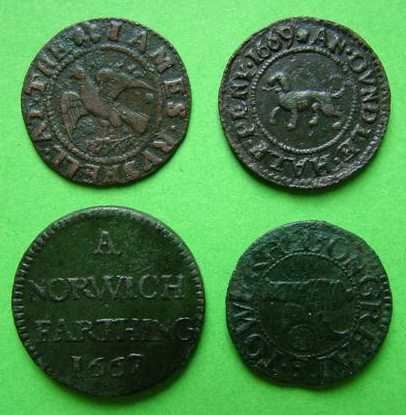
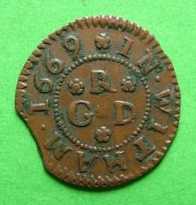
With a few exceptions the individual tokens state the name and place of the issuer(s), and in most cases state his initials, with the initial of his wife if she has one, in the centre of one side; for example, the common token of George Robinson of Witham shows R {Robinson} over GD {George, Dorcas} in triangular formation. There is no necessary implication that Dorcas was a partner in the business, and the same letter formation may be seen on many cottage foundation stones of the period. Illustration enlarged further.
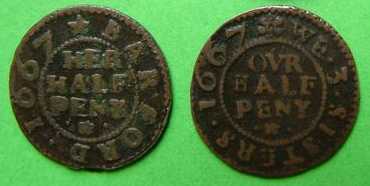
About 4% of the issuers were ladies trading in their own right, however, and doubtless some of them were widows carrying on the family business. [Her Half Peny Our Half Peny]
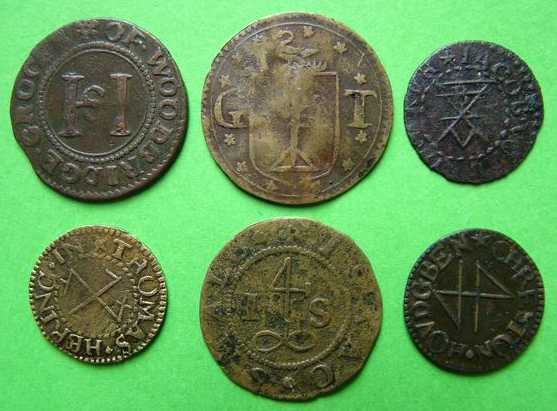
The mediaeval merchant mark was in decline by 1650, but may also still be seen instead of initials on a number of pieces.
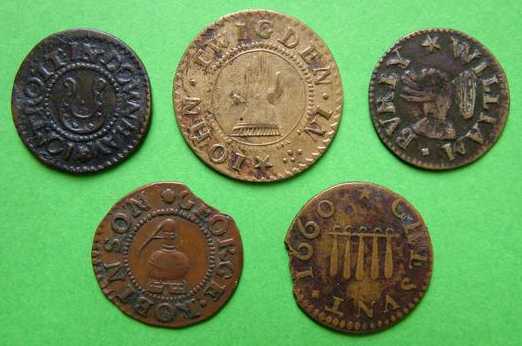
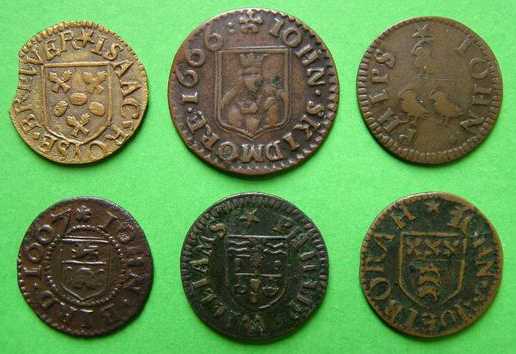
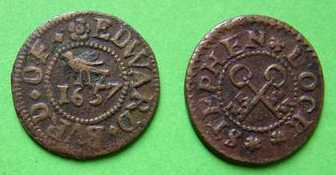
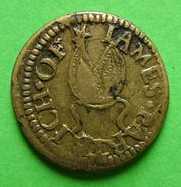
The subject matter on the second side was at the whim of the issuer, who most often used it to depict the produce, the tools or the guild arms of his trade; or, alternatively the sign outside his premises, which, in days when many more people were illiterate, were not confined to pubs as they are today. There are also a number of puns on names to be seen; issuers named Bird were likely to depict one, whilst Stephen Lock’s piece from Gosport shows a pair of keys. My favourite is a piece by a man called Partridge depicting a mitre, in which he appears to create a partridge by imaginative placement of the mitre, its tailstrings and Ramage’s mullet mintmark.
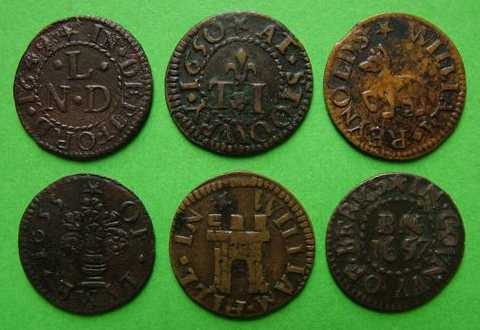
With very few exceptions the tokens had values of a farthing, a halfpenny or a penny; the last-mentioned being confined to London, the N and NW of England, and N.Wales only. The farthings are typically about 15-16mm and, except where issued by local authorities, tend not to state their value; they predominate until about 1663-64 and, whilst quite a large number are dated, many of them are not.
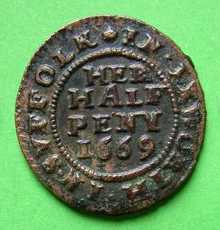
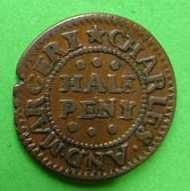
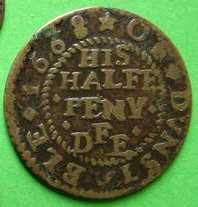
There is a lessening of issue in the period immediately after the restoration, when many desisted in the hope that Charles II would officially address the need for small change; but when this hope proved forlorn, there was another major outburst of tokens, this time chiefly halfpennies and mostly dated. They tend to be about 19-21mm and name their value, with the dates 1666-69 predominating.
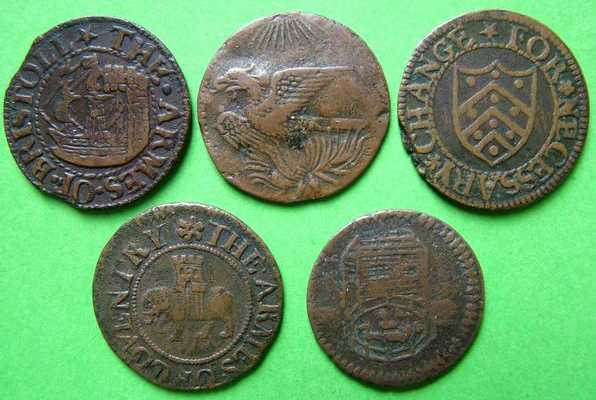

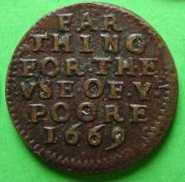
Municipal tokens are mostly of this period and of the same size, except that they tend to be farthings rather than halfpennies; intended for the use of the poor, as is usually stated or depicted quite clearly on them. Their usage was more popular in some areas than others, e.g. south to south-west England, and the northern part of East Anglia.
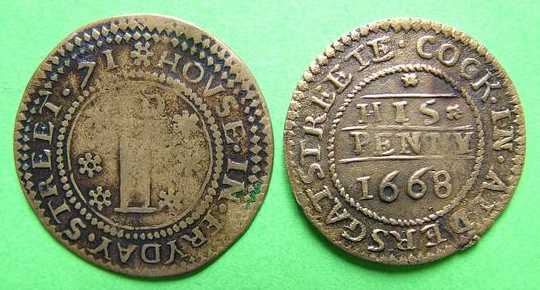
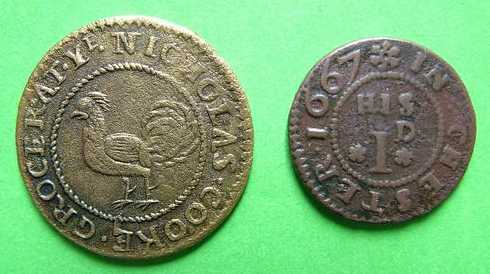
London pennies are large pieces, typically around 26mm; however, some of the provincial pennies are smaller, around the typical size of the halfpenny. Fortunately, when this occurs, they state the fact.
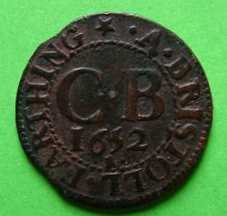
It is believed that most pieces were made by a few central manufacturers whose salesman toured the country for orders and deliveries, although only one, David Ramage {d.1662}, has been successfully identified. By far the largest issuer, there is rumour that he resorted to malpractice to preserve his near-monopoly. A few, only, of his pieces bear an "R" to mark their origin. There are numerous small marks in the field of most pieces {stars, flowers, diamonds, pellets and the like}, and it has been conjectured, without proof, that these may be indicators of provenance rather than mere decoration. In addition to manufacturers, the token industry also gave rise to the profession of "farthing changer", whose job was presumably to buy pieces up, sort them out in return for commission. One or two of these even issued their own tokens.
Literature:
G.C. Williamson’s "Trade Tokens issued in the Seventeenth century" {2 vols, 1889} remains the standard work {reprinted by Seaby in 3 vols 1967}. "Seventeenth Century Tokens of the British Isles and their Values", by M.J.Dickinson {1986} is an updated list including the pieces newly-found in the intervening century, whilst the ongoing "Sylloge of Coins of the British Isles: The Norweb Collection", by R.H.Thompson and {from vol.III} M.J.Dickinson contains by far the best collection of illustrations. Volumes I-VII so far, with one or two more to follow.
David
